Imagine you are at the 25-mile-mark of the Boston Marathon, leading the pack, with only 1.2 miles to go. Like your competition, your calves hurt and you are tired. Would you consider walking to the finish line? Many lawyers do the equivalent of walking to the finish line. After the blood, sweat, and tears of earning a favorable result in a highly contested close case, they bumble through an order that neither reflects their hard work nor protects their client’s interests. The order is not, as so many winning lawyers treat it, a secretarial afterthought; it is the reason the parties litigated, yet many winning lawyers treat is as a secretarial afterthought.
Lawyers have a duty to their clients, the court, their adversaries, and themselves to submit proposed orders that are correct, clear, and concise. Every trial lawyer should strive for a reputation of preparing proposed orders so well that judges will not hesitate to sign those orders and opposing lawyers will be reluctant to appeal them. A proposed order should reflect positively on the judge who signs it.
Lawyers should never forget their audience when preparing a proposed order. That audience includes the trial judge, the adverse attorney, the client, the adverse party, any subsequent judge from whom modification or enforcement is sought, and any appellate court asked to review the order. Write proposed orders for the entire spectrum of your audience.
The parties will rely on the order to determine their rights, perhaps for years to come. A question of enforce-ability or contempt may turn on whether the order contains clear and unambiguous instructions to the parties. Future lawyers and judges may rely on the order to decide if there has been a change of circumstances supporting a modification of child custody or visitation, child support, or alimony.
Rule 26, SCRFC, purports to control orders. It requires “specific findings of fact” and “conclusions of law” supporting the judge’s decision. Also, see Rule 52, SCRCP. By signing the order, the trial judge certifies compliance with Rule 26. The judge should issue orders “as soon as possible,” “but no later than thirty days” after the hearing. If lawyers should adhere to the requirements for findings of fact and conclusions of law, judges should take their certification of compliance seriously.
A good order contains three sections: statement of the case, findings of fact, and conclusions of law.
• The statement of the case establishes the personal and subject matter jurisdiction of the court, and then explains how the case came before the court, what each party seeks, and the issues. It is unnecessary to recite every routine document, such as a proof of service, notice of appearance, or notice of hearing found in the record. It is necessary to state what each party seeks because if the order does not address every issue raised by the pleadings, it is a temporary order, not a final order. See Bolding v. Bolding, 283 S.C. 501, 323 S.E.2d 535 (Ct. App. 1984) or Sexton v. Sexton, 308 S.C. 37, 39, 416 S.E.2d 649, 651 (Ct. App. 1992), rev'd, 310 S.C. 501, 427 S.E.2d 665 (1993). Ms. Sexton and her lawyer thought she had a final order dividing the personal property, granting a divorce, custody, and child support, but she had only a temporary order.
• The findings of fact are what the trial judge finds as fact. This is not a restatement of the testimony. A witness’ testimony is not a fact unless the judge finds it is a fact. The facts may state the applicable law. The facts must include testimonial or evidentiary support for each element for each form of relief awarded. These findings are necessary for affirmance of the order on appeal and for determining any future right to modification based upon changes in circumstance.
• Few lawyers and judges understand conclusions of law. Contrary to popular opinion, conclusions of law are not citations of authority nor a factual finding the court has jurisdiction. The conclusions of law result from applying the law of the jurisdiction to the facts. The conclusions of law follow, “It is therefore ordered.” The conclusions of law are not a restatement of the findings of fact; they are the conclusions that tell the parties what they must or must not do. The conclusions of law must be clear, concise, and definite if the court is to enforce the order. “One may not be convicted of contempt for violating a court order which fails to tell him in definite terms what he must do. The language of the commands must be clear and certain rather than implied.” Phillips v. Phillips, 288 S.C. 185, 188, 341 S.E.2d 132, 133 (1986).
• The order must state the findings of fact and conclusions of law separately. It must not state the findings of fact and then state “And it is so ordered” rather than separately stating the conclusions of law. Rule 52(a), SCRCP, and Rule 26(a), SCRFC.
An order is a reflection, for better or worse, on the judge who signs it, not the lawyer who prepared it. However, a lawyer preparing an order that makes the judge look like a fool is not likely to prepare many future orders for that judge.
I will post §§ II Essentials and Clarity III Wednesday, June 9, 2021.




Thomas:
An excellent explanation. The only two things I would add is what a kindly Family Court Judge told me when I first started practicing 40 years ago. Specifically, that the first two paragraphs should explain to the reader why they are reading it: “This matter comes before me upon Motion of Plaintiff-Wife for temporary custody of the parties’ two minor children, child support, exclusive possession of the marital residence and attorneys fees. In his Answer and Counterclaim Husband ….. As set forth in more detail below I find the parties shall have joint custody with Wife being designated primary custodian…..”
In other words, summarize the Order at the very beginning so no one has to go all the way through it to understand what it does.
The second thing was let the Order bake overnight -or at least a few hours- so you can re-read it cold, with the question in the back of your mind always being whether an 8th grader would understand it. If not, fix those parts so it’s clear.
Just my two pesos.